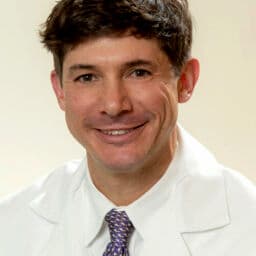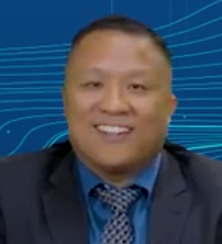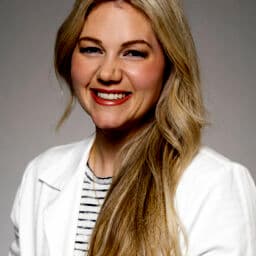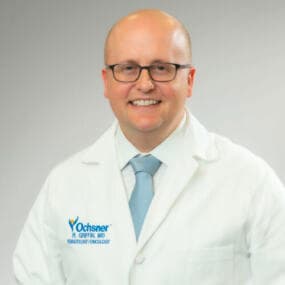Curability, Maintenance Therapy, and Unmet Needs in Multiple Myeloma
A recent Satellite Sessions program hosted by CancerNetwork® brought together experts from different Ochsner Health campuses to discuss the diversity of practices among care providers regarding patient interactions and treatment choices.
Andrew Dalovisio, MD
Interim Head of Hematology and Stem Cell Transplant
Co-Director, Adolescent and Young Adult Oncology Program

Ernest C. Quintin, MD
General Oncologist

Thomas Atkinson, MD
Hematologic Oncologist

Kelly Pippin, MD
Hematologic Oncologist

Ryan Griffin, MD
Oncologist

A recent Satellite Sessions program hosted by CancerNetwork® brought together experts from different Ochsner Health campuses to discuss the diversity of practices among care providers regarding patient interactions and treatment choices.
The panel was led by Andrew Dalovisio, MD, interim head of the Hematology and Stem Cell Transplant Program, and co-director of the Young Adult Oncology Program located at the St. Tammany Cancer Center in Covington, Louisiana. Panelists included Ernest C. Quintin, MD, an oncologist at the Leonard J. Chabert Medical Center in Houma, Louisiana; Thomas Atkinson, MD, a hematologic oncologist located at Ochsner MD Anderson Cancer Center in Kenner, Louisiana; Kelly Pippin, MD, a hematologic oncologist at the St. Tammany Cancer Center; and Ryan Griffin, MD, an oncologist specializing in hematology and neuroendocrine oncology at Ochsner MD Anderson Cancer Center in Kenner.
The panel explored the question of curability in multiple myeloma, traded thoughts on the best ways to inform patients about their treatments, and shared their experiences with various therapies in maintenance and other settings. They also touched on some challenges to optimal care facing community oncology practices.
Q: What discussion do you have with patients who are transplant-eligible, both initially and prior to their transplant? What do you tell them?
QUINTIN: Historically, [multiple myeloma carried] such a poor prognosis that it was a very difficult conversation to have. Nowadays, the quantity of drugs keeps increasing. If we can get a deeper response faster, that’s what buys you the most time down the road, and that’s how I talk to my patients about it. I tell them, “You went through all of this in the beginning so that we could get you to a position where we can do even better with a transplant.”
GRIFFIN: Transplantation, in my experience, has sometimes been a tougher sell in the community setting. Post-pandemic, patients are hesitant to sign up for a week-long or longer stay in the hospital. When I see a new patient with multiple myeloma, I describe the disease as a very complex condition. I tell them, “I’m going to refer you to our multiple myeloma experts at our main campus. There are many different therapies, they’ll discuss certain options with you.” I let [the experts at the main campus] frame the first discussion about transplant. On the second or third visit, patients come back with questions, and I try to tease out their goals and preferences and smooth the discussion.
PIPPIN: I’m a visual [learner], so I like to draw them a picture. I’ll draw a line down, and I’ll tell them, “This is how far we can get with the intravenous therapies.” Then, I’ll draw another line way further down and say, “This is what a stem cell transplant can get you.” I think of it almost like a submarine, drawing down to get the disease as minimally detected as possible.
ATKINSON: I will mention transplant to anyone I think is eligible as soon as we’ve confirmed the diagnosis. I then start teasing out their preferences. Historically, I would send almost everyone for a referral right away. As I’ve grown a little bit, I’ve realized that there are certain patients who are simply ineligible or unwilling, and it won’t be a good use of your time to try convincing them. I don’t send 100% of my patients, but it’s crucial that a patient with newly diagnosed disease be referred for transplant as soon as possible.
Q: At this point, is it fair to tell patients that multiple myeloma is curable?
DALOVISIO: It’s a curable disease in a small group of patients now. We still need long-term data from the trials of quadruplet therapies, but I suspect that [the proportion of patients with curable disease] will probably increase to about 20% or 30%. That’s comparable to some later-stage solid tumors. I don’t want to sugarcoat it—most patients will succumb—but in standard-risk disease, which fortunately accounts for a majority of cases, there’s not an unreasonable chance of a remission period lasting beyond 10 or 15 years. For many patients, that would get them to the finish line.
ATKINSON: That shift in mindset, from multiple myeloma as a permanent chronic illness to a curable disease, is profoundly important in the broader oncology community. If patients continue to think of multiple myeloma as this terrible condition that can’t be treated or cured, [the pessimism will] have a very negative impact on them.
Q: Are you successfully keeping patients on full-dose pomalidomide [Pomalyst] as a maintenance therapy?
DALOVISIO: In the maintenance setting, I tend to [use a dosage of] 1 mg or 2 mg, extrapolated from lenalidomide [Revlimid], with which you use approximately half the dose [as maintenance therapy]. My experience is that pomalidomide is a bit better-tolerated. It tends to have a similar adverse effect [AE] profile.
ATKINSON: The fact that you can use it [in patients] with renal dysfunction much more easily [than lenalidomide] is super nice.
QUINTIN: For whatever reason, my patients just hate pomalidomide. They get through the lenalidomide well, and then the pomalidomide becomes a major issue, to the point of [necessitating] dose reductions, maybe not in the maintenance setting but in the relapsed setting.
Q: Do you feel comfortable administering bispecific T-cell engager [BiTE] therapies at your locations? Is it something you’d want the main campus to handle?
PIPPIN: I would not be comfortable. Often there’s a lack of comfort with the nurses. We’re always comfortable with what we do often and, because [BiTE therapy] is rarer, [administering it] would be quite nerve-wracking. I wonder if [our nurses] would be able to grade the cytokine release syndrome [CRS]. I worry that there would be a lot of nervousness.
GRIFFIN: The other challenge we would have in community practice is a lack of chemotherapy-certified nurses in the inpatient setting. That limits [our ability to use] a lot of inpatient therapies.
DALOVISIO: Eventually we could get to a point where [care providers in the community setting] are comfortable administering [tocizilumab; Actemra] for CRS. Ochsner Health Center - Covington is certified to give tocilizumab, and so certainly some of the smaller infusion rooms can handle it. For me, CRS is a giant boogeyman. Obviously, severe CRS, as you can see with CAR T-cell therapy, is scary, but the CRS we see with bispecifics is mild. When talking to other physicians, I say, “Look, you manage neutropenic sepsis in a hospital. To me, that’s 10 times scarier than this.” It’s just [a matter of] demystifying it.
Q: What are the most major unmet needs in this disease space?
PIPPIN: A lot of primary care [providers] are not comfortable [providing] the initial diagnosis. It would be beneficial to [diagnose] this [disease] early, when people are a little younger, by recognizing a globulin gap. Often, nurse practitioners or primary care doctors, when they order a free light chains test, [may not] know what [the results] mean, and how to interpret them. [It’s also critical to] recognize the signs and symptoms of early disease and diagnose it before there’s a hip fracture. Preventative strategies are our friends. Getting folks to recognize the signs and symptoms of this disease in the primary care setting is one of the biggest things we could do to prevent some of the morbidity.
GRIFFIN: We need to be trying as hard as possible to give patients treatment-free options. [For example], I like the phase 2 MASTER study [NCT03224507], [which assessed] the use of minimal residual disease testing to get patients off maintenance. Maintenance [means] you’re still taking chemotherapy, so it’s almost a disservice to tell patients it’s maintenance because it’s still chemotherapy. Getting people to treatment-free periods is a huge [unmet] need.
DALOVISIO: I’m a bad offender with regard to this. I’ll think, “It’s just lenalidomide.” However, you forget lenalidomide makes a patient feel crummy. I’ll have people who are on lenalidomide maintenance for 5 years, and when they finally stop, they say, “Oh my God, I feel like myself again.” It’s easy to forget that [because] patients are willing to take [the maintenance] since it’s keeping their cancer in remission.
QUINTIN: In my community practice, I always have the question of sustainability. CAR T-cell therapies [can cost] $500,000 a year. Some of my patients have problems reaching day 1, day 4, day 8, or day 11 of the lenalidomide, so nobody wants to talk about money and where it’s coming from. There’s a Louisiana senator who said, “When you’re poor and you’re sick, you’re still poor.” That’s an unmet need—the ability to even get some of these treatments to the patients that need them.
ATKINSON: I would echo that. The cost of these drugs can be exorbitant and, while we’ve made such [amazing] progress [with respect to] treatment, the economic cost is very hard to shoulder for a lot of patients. It’s easy not to think about the financial toxicity, but if you engage your patients with those discussions, it can be gut-wrenching to hear about the financial toxicity from [some of these therapies]. Lenalidomide is a major offender in terms of financial toxicity.
DALOVISIO: Most of these patients live longer than a decade now, so they have to deal with this financial toxicity for 10 years or more. I have patients who tell me, “I can’t pay 2 grand a month for lenalidomide, that’s my savings.” Everyone is affected by this, and it’s also something that treatment-free periods would [help alleviate].
EP: 1.Overview on Risk Stratification in Multiple Myeloma
EP: 2.Triplet Induction Therapy in Patients With Transplant-Eligible NDMM
EP: 3.Quadruplet Induction Therapy in Patients With Transplant-Eligible NDMM
EP: 4.Transplant-Eligible NDMM: Selecting Induction Therapy Based on Risk Status
EP: 5.What is the Role of Transplant in Treating Patients With NDMM?
EP: 6.Determining Transplant Ineligibility in Newly Diagnosed Multiple Myeloma
EP: 7.Curability, Maintenance Therapy, and Unmet Needs in Multiple Myeloma
EP: 8.Frontline Treatment Regimens in the Setting of Transplant-Ineligible NDMM
EP: 9.Optimizing Treatment Strategies in Relapsed/Refractory Multiple Myeloma
EP: 10.Relapsed/Refractory Multiple Myeloma: Managing Patients on Bispecific Therapy
EP: 11.Role of CAR T-cell Therapy in Patients With Relapsed/Refractory Multiple Myeloma
EP: 12.Unmet Needs and Future Directions in the Management of Multiple Myeloma
Navigating AE Management for Cellular Therapy Across Hematologic Cancers
A panel of clinical pharmacists discussed strategies for mitigating toxicities across different multiple myeloma, lymphoma, and leukemia populations.